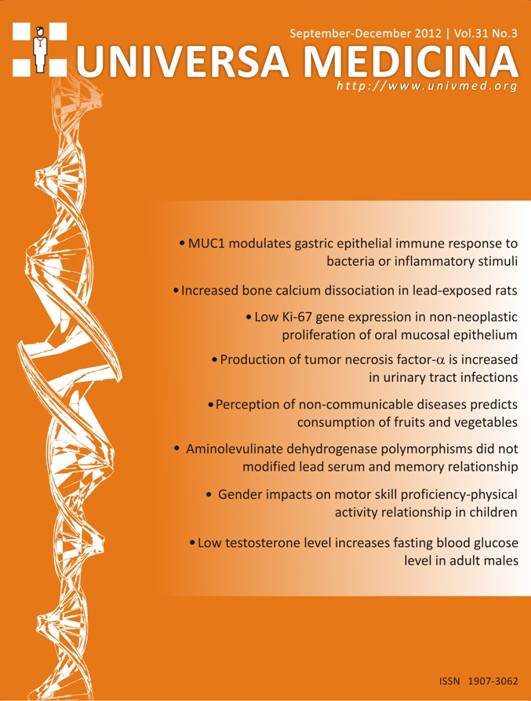MUC1 modulates gastric epithelial immune response to bacteria or inflammatory stimuli
Main Article Content
Abstract
Article Details
Issue
Section
The journal allows the authors to hold the copyright without restrictions and allow the authors to retain publishing rights without restrictions.
How to Cite
References
Linden SK, Sutton P, Karlsson NG, Korolik V, McGuckin MA. Mucins in the mucosal barrier to infection. Mucosal Immunol 2008;1:183-97.
Hattrup CL, Gendler SJ. Structure and function of the cell surface (tethered) mucins. Annu Rev Physiol 2008;70:431-57.
Kobayashi M, Lee H, Nakayama J, Fukuda, M. Roles of gastric mucin-type O-glycans in the pathogenesis of Helicobacter pylori infection. Glycobiology 2009;19:453-61.
McAuley JL, Linden SK, Ping CW, King RM, Pennington HL, Gendler SJ, et al. MUC1 cell surface mucin is a critical element of the mucosal barrier to infection. J Clin Invest 2007;117:2313-24.
McGuckin MA, Every AL, Skene CD, Linden SK, Chionh YT, Swierczak A, et al. MUC1 mucin limits both Helicobacter pylori
colonization of the murine gastric mucosa and associated gastritis. Gastroenterology 2007;133:1210-8.
Linden SK, Sheng YH, Every AL, Miles KM, Skoog EC, Florin TH, et al. MUC1 limits Helicobacter pylori infection both by steric
hindrance and by acting as a releasable decoy. PLoS Pathog 2009;5:e1000617.
Lu W, Hisatsune A, Koga T, Kato K, Kuwahara I, Lillehoj EP, et al. Cutting edge: enhanced pulmonary clearance of Pseudomonas aeruginosa by MUC1 knockout mice. J Immunol 2006;176:3890-4.
Ueno K, Koga T, Kato K, Golenbock DT, Gendler SJ, Kai H, et al. MUC1 mucin is a negative regulator of toll-like receptor signaling. Am J Respir Cell Mol Biol 2008;38:263-8.
Guang W, Ding H, Czinn SJ, Kim KC, Blanchard TG, Lillehoj EP. MUC1 cell surface mucin attenuates epithelial inflammation in
response to a common mucosal pathogen. J Biol Chem 2010;285:20547-57.
Lillehoj EP, Kim H, Chun EY, Kim KC. Pseudomonas aeruginosa stimulates phosphorylation of the airway epithelial
membrane glycoprotein MUC1 and activates MAP kinase. Am J Physiol Lung Cell Mol Physiol 2004;287:L809-15.
Thompson EJ, Shanmugam K, Hattrup CL, Kotlarczyk KL, Gutierrez A, Bradley JM, et al. Tyrosines in the MUC1 cytoplasmic tail modulate transcription via the extracellular
signal-regulated kinase 1/2 and nuclear factorkappa B pathways. Mol Cancer Res 2006;4:489-97.
Ahmad R, Raina D, Trivedi V, Ren J, Rajabi H, Kharbanda S, et al. MUC1 oncoprotein activates the I kappa B kinase beta complex and constitutive NF-kappa B signalling. Nat Cell Biol
;9:1419-27.
Hickey TE, McVeigh AL, Scott DA, Michielutti RE, Bixby A, Carroll SA, et al. Campylobacter jejuni cytolethal distending toxin mediates release of interleukin-8 from intestinal epithelial
cells. Infect Immun 2000;68:6535-41.
Zheng J, Meng J, Zhao S, Singh R, Song W. Campylobacter-induced interleukin-8 secretion in polarized human intestinal epithelial cells requires Campylobacter-secreted cytolethal
distending toxin- and Toll-like receptor-mediated activation of NF-kappa B. Infect Immun 2008;76:4498-508.
Wajant H, Pfizenmaier K, Scheurich P. Tumor necrosis factor signaling. Cell Death Differ 2003;10:45-65.
Bradley JR. TNF-mediated inflammatory disease. J Pathol 2008;214:149-60.
Li Y, Dinwiddie DL, Harrod KS, Jiang Y, Kim KC. Anti-inflammatory effect of MUC1 during respiratory syncytial virus infection of lung epithelial cells in vitro. Am J Physiol Lung Cell Mol Physiol 2010;298:L558-63.


